OLDSMOBILE BRAVADA 1996 Manual PDF
Manufacturer: OLDSMOBILE, Model Year: 1996, Model line: BRAVADA, Model: OLDSMOBILE BRAVADA 1996Pages: 340, PDF Size: 17.49 MB
Page 71 of 340
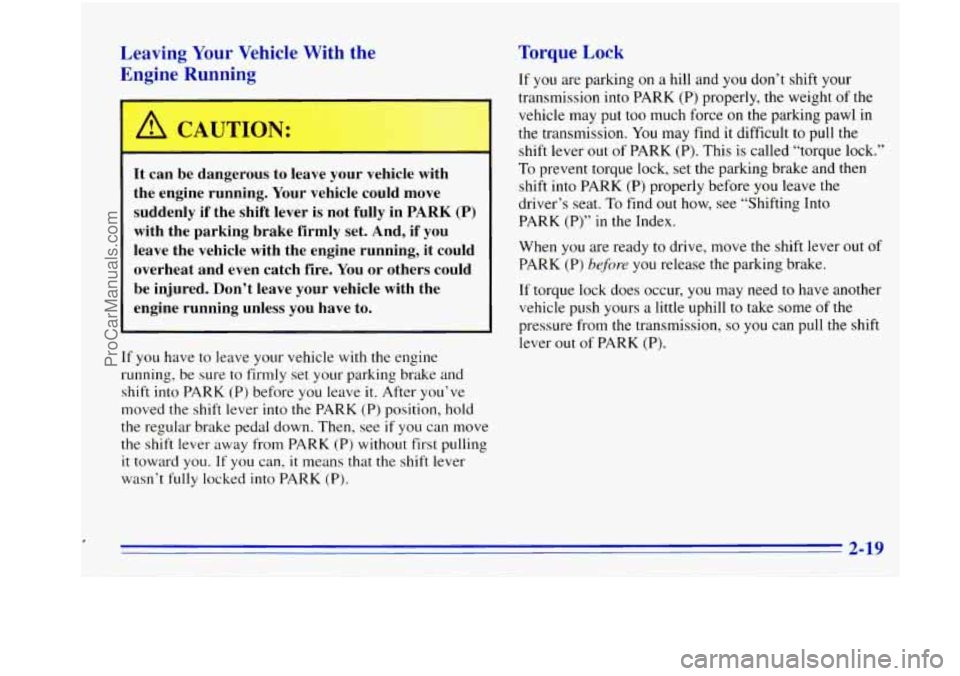
Q
Leaving Your Vehicle With the
T“-lgi-- - Yunning
It can be dangerous to leave your vehicle with
the engine running. Your vehicle could move
suddenly if the shift lever is not fully in
PARK (P)
with the parking brake firmly set. And, if you
leave the vehicle with the engine running, it could
overheat and even catch fire. You or others could
be injured. Don’t leave your vehicle with the
engine running unless you have to.
If you have to leave your vehicle with the engine
running, be sure to firmly set your parking brake and
shift into PARK (P) before you leave
it. After you’ve
moved the shift lever into the PARK (P) position, hold
the regular brake pedal down. Then, see
if you can move
the shift lever away from PARK (P) without first pulling
it toward you. If you can, it means that the shift lever
wasn’t
fully locked into PARK (P).
Torque Lock
If you are parking on a hill and you don’t shift your
transmission into PARK (P) properly, the weight of the
vehicle may
put too much force on the parking pawl in
the transmission. You may find it difficult to pull the
shift lever out of PARK
(P). This is called “torque lock.”
To prevent torque lock, set the parking brake and then
shift into PARK (P) properly before
you leave the
driver’s seat.
To find out how, see “Shifting Into
PARK
(P)” in the Index.
When
you are ready to drive, move the shift lever out of
PARK (P) before you release the parking brake.
If torque lock does occur, you may need
to have another
vehicle push yours a
little uphill to take some of the
pressure from the transmission,
so you can pull the shift
lever out of PARK
(P).
ProCarManuals.com
Page 72 of 340
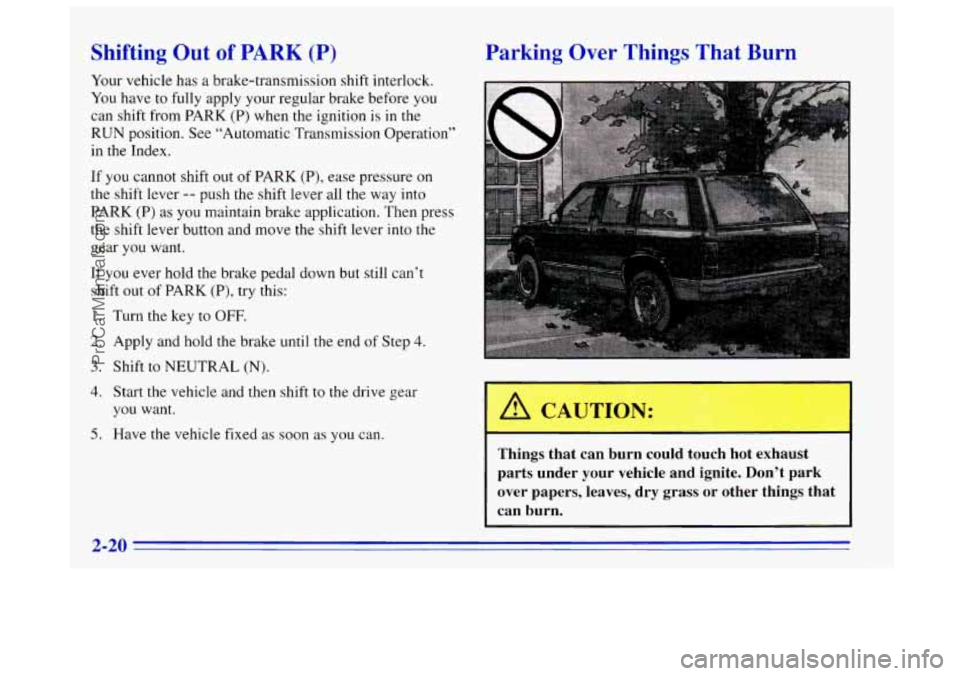
Shifting Out of PARK (P)
Your vehicle has a brake-transmission shift interlock.
You have to
fully apply your regular brake before you
can shift from PARK (P) when the ignition is in the
RUN position. See “Automatic Transmission Operation”
in
the Index.
If you cannot shift out
of PARK (P), ease pressure on
the shift lever
-- push the shift lever all the way into
PARK (P) as you maintain brake application. Then press
the shift lever button and move the shift lever into the
gear
you want.
If you ever hold the brake pedal down but still can’t
shift out
of PARK (P), try this:
1. Turn the key to OFF.
2. Apply and hold the brake until the end of Step 4.
3. Shift to NEUTRAL (N).
4. Start the vehicle and then shift to the drive gear
you want.
5. Have the vehicle fixed as soon as you can.
Parking Over Things That Burn
1
Things that can burn could touch hot exhaust
parts under your vehicle and ignite. Don’t park
over papers, leaves, dry grass or other things that
can burn.
1
2-20
ProCarManuals.com
Page 73 of 340
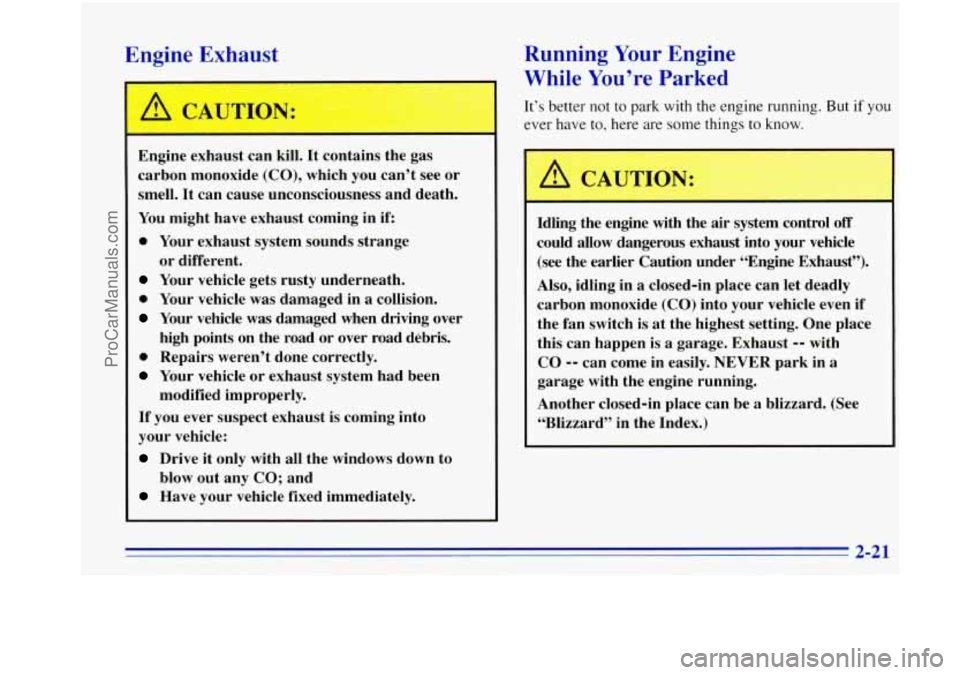
Engine Exhaust
Engine exhaust can kill. It contains the gas
carbon monoxide
(CO), which you can’t see or
smell. It can cause unconsciousness and death.
You might have exhaust coming in if:
0 Your exhaust system sounds strange
Your vehicle gets rusty underneath.
0 Your vehicle was damaged in a collision.
Your vehicle was damaged when driving over
high points on the road or over road debris.
0 Repairs weren’t done correctly.
Your vehicle or exhaust system had been
If you ever suspect exhaust is coming into
your vehicle:
Drive it only with all the windows down to
Have your vehicle fixed immediately.
or different.
modified improperly.
blow out any CO; and
Running Your Engine
While You’re Parked
It’s better not to park with the engine running. But if you
ever have to, here are some things to know.
A CAUTION:
Idling the engine with the air system control off
could allow dangerous exhaust into your vehicle
(see the earlier Caution under “Engine Exhaust”).
Also, idling in a closed-in place can let deadly
carbon monoxide
(CO) into your vehicle even if
the fan switch is at the highest setting. One place
this can happen is
a garage. Exhaust -- with
CO -- can come in easily. NEVER park in a
garage with the engine running.
Another closed-in place can be
a blizzard. (See
“Blizzard” in the Index.)
2-21
ProCarManuals.com
Page 74 of 340
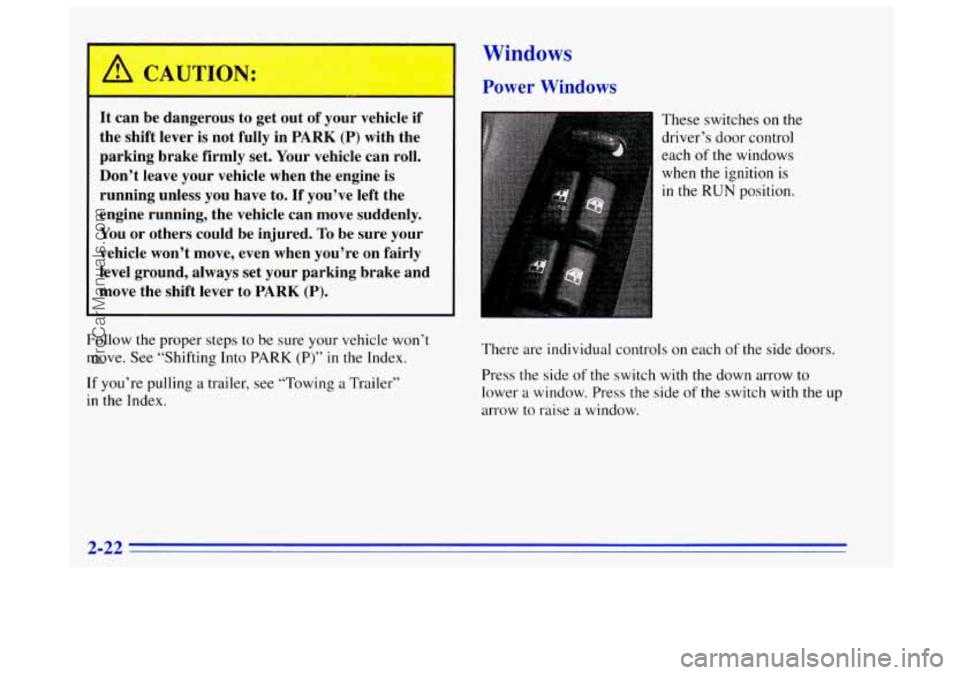
It can be dangerous to get out of your vehicle if
the shift lever is not fully in
PARK (P) with the
parking brake firmly set. Your vehicle can roll.
Don’t leave your vehicle when the engine
is
running unless you have to. If you’ve left the
engine running, the vehicle can move suddenly.
You or others could be injured.
To be sure your
vehicle won’t move, even when you’re on fairly
level ground, always set your parking brake and
move the shift lever to
PARK (P).
Follow the proper steps to be sure your vehicle won’t
move. See “Shifting Into
PARK (P)” in the Index.
If you’re pulling a trailer, see “Towing a Trailer”
in the Index.
Windows
Power Windows
These switches on the
driver’s door control
each
of the windows
when the ignition is
in the RUN position.
There are individual controls
on each of the side doors.
rress the side
of the switch with the down arrow to
lower
a window. Press the side of the switch with the up
arrow to raise a window.
2-22
ProCarManuals.com
Page 75 of 340
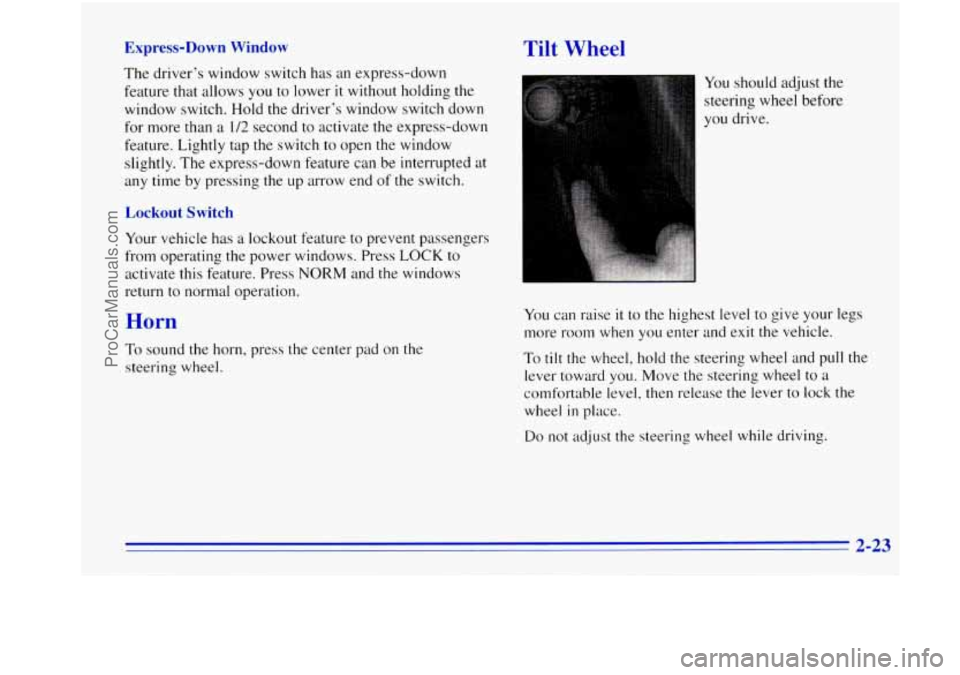
Express-Down Window
The driver’s window switch has an express-uown
feature that allows you to lower it without holding the
window switch. Hold the driver’s window switch down
for more than
a 1/2 second to activate the express-down
feature. Lightly tap the switch to open
the window
slightly. The express-down feature can be interrupted at
any time by pressing the up arrow end of the switch.
Tilt Wheel
Lockout Switch
Your vehicle has a lockout feature to prevent passengers
from operating the power windows. Press
LOCK to
activate this feature. Press
NORM and the windows
return to normal operation.
Horn
To sound the horn, press the center ad on the
steerine wheel. You
should adjust the
steering wheel before
you drive.
You can raise it to the highest level to give your legs
more room when
you enter and exit the vehicle.
To
tilt the wheel, hold the steering wheel and pull the
lever toward
you. Move the steering wheel to a
comfortable level, then release the lever to lock the
wheel
in place.
Do not adjust the steering wheel while driving.
2-23
~
ProCarManuals.com
Page 76 of 340

Turn Signal/Multifunction Lever Turn and Lane Change Signals
The turn signal has two upward (for right) and two
downward (for left) positions. These positions allow you
to signal a turn or a lane change.
To signal a turn, move the lever all the way up
or down. When the
turn is finished, the lever will
return automatically.
The lever on
the left side of the steering column
includes your:
0 Turn Signal and Lane Change Indicator
0 Headlamp High/Low Beam Changer
Windshield Wipers
0 Windshield Washer
Cruise Control An
arrow on the instrument
panel will flash
in the
direction of the turn
or lane change.
To signal a lane change, just raise or lower the lever
until the arrow starts to flash. Hold it there until you
complete
your lane change. The lever will return by
itself when you release it.
2-24
ProCarManuals.com
Page 77 of 340

As you signal a turn or a lane change, if the arrows don’t
flash but just stay on,
a signal bulb may be burned out
and other drivers won’t see your turn signal.
If a bulb is burned out, replace it to help avoid an
accident. If the arrows don’t go on at all when you
signal
a turn, check the fuse (see “Fuses and Circuit
Breakers” in the Index) and for burned-out bulbs.
If you have a trailer towing option with added wiring for
the trailer lamps,
a different turn signal flasher is used.
With this flasher installed, the signal indicator will flash
even if
a turn signal bulb is burned out. Check the front
and rear turn signal lamps regularly to make sure they
are working.
Headlamp HighLow Beam Changer
To change the headlamps from low beam to high or high
to low, pull the multifunction lever all the way toward
you. Then release
it.
When the high beams are
on, this indicator light on
the instrument panel will
also be on.
2-25
ProCarManuals.com
Page 78 of 340

Windshield Wipers
You control the windshield wipers by turning the band
with the wiper symbol
on it.
For a single wiping cycle, turn the band t.o
MIST. Hold
it there until the wipers start, then let go. The wipers will
stop after one wipe. If
you want more wipes, hold the
band on MIST longer.
You can set the wiper speed for a long or short delay
between wipes. This can be very useful
in light rain or
snow. Turn the band
to choose the delay time. The
closer to
LOW, the shorter the delay. For steady wiping at low speed,
turn the band away
from you to the LOW position. For high-speed wiping,
turn the band further, to
HIGH. To stop the wipers,
move the band
to the OFF position.
Be sure to clear ice and snow from the wiper blades
before using them. If they’re frozen to the windshield,
carefully loosen or thaw them. If your blades do becomc
worn or damaged, get new blades or blade inserts.
Windshield Washer
At the top of the multifunction lever, there’s a paddle
marked with the windshield washer symbol and
PUSH.
To spray washer fluid on the windshield, press the
paddle. The wipers will clear
the window and then
either stop
or return to your preset speed.
In freezing weather, don’t use your washer until
the windshield is warmed. Otherwise the washer
fluid can form ice on the windshield, blocking
your vision.
2-26
ProCarManuals.com
Page 79 of 340

Rear Window WasherNiper
WASH
REAR WIPER
The rear window wiper operates with a constant five
second delay when the rear wiper switch
is in the ON
position. If the rear glass is opened, the wiper arm will
automatically park on the endgate. When the glass
is
completely closed, the wiper will resume the delay mode.
To wash the window, press and hold ON. The wipers
will continue
to work after you release the switch.
Press
OFF to turn the wiper off.
The rear window washer uses the same fluid bottle as
the windshield washer. However, the rear window
washer will run out
of fluid before the windshield
washer.
If you can wash your windshield but not your
rear window, check your fluid level.
This switch is located on the instrument panel.
2-27
ProCarManuals.com
Page 80 of 340

Cruise Control
With cruise control, you can
maintain
a speed of about
25 mph (40 km/h) or more
without keeping your foot
on the accelerator. This can
really help on long trips.
Cruise control does not
work at speeds below about
25 mph (40 km/h).
If you apply your brakes, the cruise control will shut off. Setting Cruise Control
Cruise control can be dangerous where
you
can’t drive safely at
a steady speed. So,
don’t use your cruise control on winding
roads or in heavy traffic.
slippery roads. On such roads, fast changes
in tire traction can cause needless wheel
spinning, and you could lose control. Don’t
use cruise control on slippery roads.
Cruise control can be dangerous on
If you leave your cruise control switch on when
you’re not using cruise, you might hit a button and
go into cruise when you don’t want to. You could
be startled and even lose control. Keep the cruise
control switch
OFF until you want to use it.
1. Move the cruise control switch to ON,
2. Get up to the speed you want.
3. Press in the SET button
at the end of the lever
and release
it.
4. Take your foot off the accelerator pedal.
ProCarManuals.com